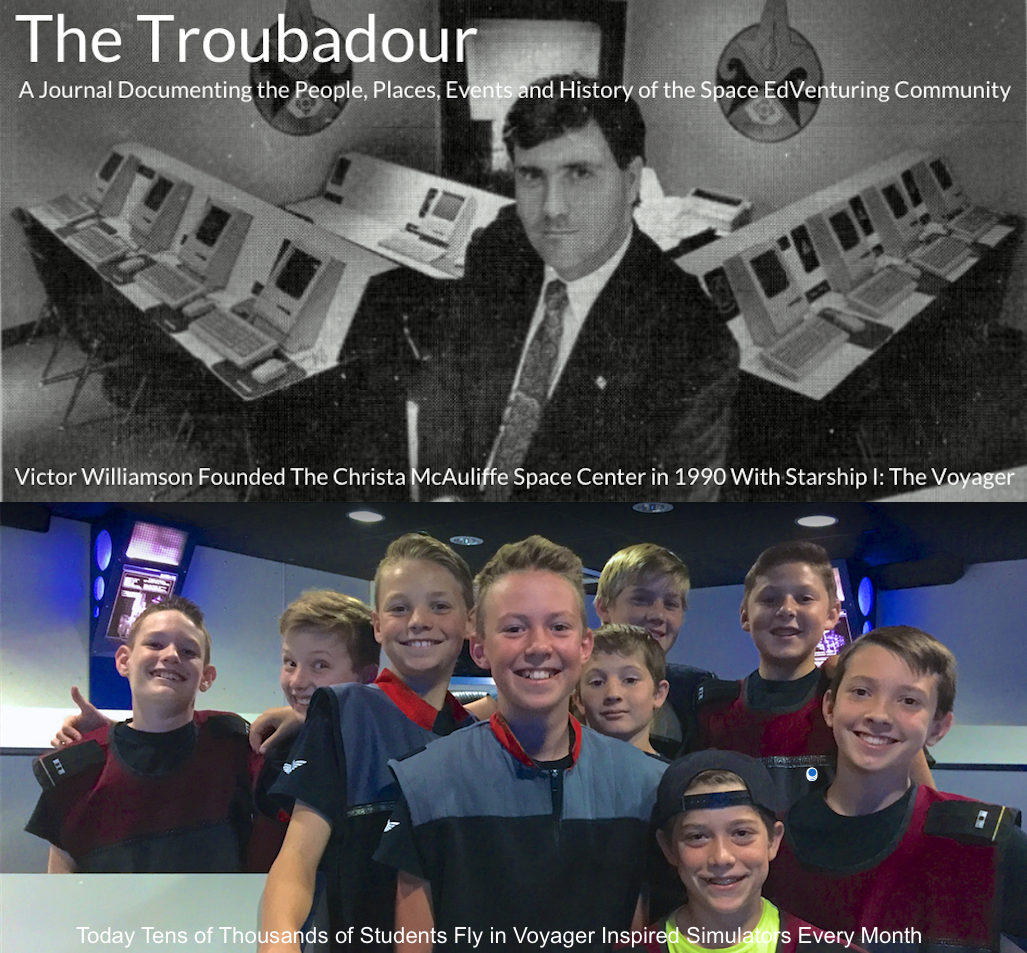 |
| Megan in the Everest Control Room at the Telos Discovery Space Center, Pleasant Grove |
 |
| Megan and Jon Parker at the Space Center. Megan, like me, survives only by sticky note |
Megan is no stranger to running a space center organization. Megan took the reigns of the Christa McAuliffe Space Education Center when I retired at the the end of May 2013. She kept the Space Center together and functioning during what could have been a very difficult year, but wasn't thanks to her skills, professionalism, and dedication to the spirit of the center and its mission. She did an excellent job during that transition year while the school district searched for a teacher/director to administer the center.
Megan took a break from Utah and moved to California to be with family after James Porter assumed control of the CMSEC as director. Spending three years in California was enough for her. She returned to Utah a few months ago.
Being in the right place at the right time is Megan's philosophy. I personally believe she and Fortuna, the Goddess of Fortune, have some kind of special bond. Did she know she'd be hired to become the program director for the Discovery Space Center when she came back to Utah? Of course not. It was fortune, or luck, or divine providence; because at the same time she returned, Telos Academy acquired the Discovery Space Center. A program director was needed to oversee the DSC's two locations at Canyon Grove and Merit Academies in Pleasant Grove and Springville. Megan interviews with Telos's Ryan Anderson and officially took the directorship on Friday.
 |
| Megan and DSC Canyon Grove Site Manager Maeson Busk on the DSC's Pathfinder |
Megan will be responsible for supervision, operations, development, and staff training for both DSC locations. Working with her at Canyon Grove will be the center's on site manager Maeson Busk.
Working with her as site manager at Merit Academy in Springville is Sarah Glad.
Having Megan as DSC Program Director takes us one step closer to creating an association of space education centers which all share the same mission: Teaching the Discipline of Wonder. Renaissance Academy's Farpoint Space Education Center and the Telos DSC are already partnered in the creation of the new Farpoint Universe. With Farpoint comes new missions, new starship simulator controls, and continuing opportunities for advancement, growth, and experiential education scholarship.
During our discussions both Megan and I agreed on the benefit of having uniform flight director training for all Farpoint Universe simulators. To that end, we discussed the creation of a Flight Director Association with regular socials, workshops, and trainings. The FDA would guarantee uniform training system wide and allow flight directors to work at any Farpoint Universe location.
Welcome back to space education center administration Megan. There is much to do.
Mr. Williamson
Meet Last Week's Farpoint Space Education Center's Long Duration Mission Squadrons
We were busy again last week at Renaissance Academy's Farpoint Space Education Center flying our 27 long duration mission squadrons. Every afternoon another squadron beamed up to the USS Voyager for their first long duration mission of the 2016-2017 season. As I've mentioned many times before; outstanding students, outstanding cadets, outstanding missions, and a highly trained staff. I've never had so much fun!
 |
| Tuesday's 6th Grade Scorpion Squadron |
 |
| Wednesday's 7th - 9th Grade Phoenix Squadron |
 |
| Thursday's 7-9th Grade Lion Squadron Commanders |
 |
| Farpoint's 7-9th Grade Lion Squadron |
 |
| Friday's 7-9th Grade Tiger Squadron Commanders |
 |
| Farpoint's 7-9th Grade Tiger Squadron |
Space News
By Mark DaymontSpacerubble.blogspot.com
ISS: Busy Traffic Week
Current Spacecraft positions on the ISS. Credit: NASA.
It was a very busy week for the crew of Expedition 50 on the International Space Station. In between station maintenance, science experiments, and preparations for future work, the crew needed to be on their toes dealing with all the intricacies of arriving robotic spacecraft.
Launch Pad 39B with the SpaceX Falcon rocket. Launch Control and the Vehicle Assembly Building seen in the background. SpaceX.
Events started with a roar on Sunday. From the historic LC-39B pad, SpaceX launched Dragon 10, their unmanned cargo spacecraft, on a mission to take supplies to the ISS. The launch went very well, and Dragon began its 2 day voyage to rendezvous with the station.
First launch from Pad 39B since the retirement of the shuttle in 2011.
In a historic first, the Dragon 10 lifted off from its pad on the Falcon rocket as the first commercial rocket to launch from the famous pad 39, where decades earlier the astronauts flew the mighty Saturn Vs to the Moon in project Apollo, and then later when the space shuttles began their routine missions into low Earth orbit. This pad site has been modified from the shuttle operations to accept more commercially-operated designs. It is currently leased to SpaceX, which previously had been using the Pad 40 on the Cape Canaveral Air Force station. That pad was damaged in a Falcon Explosion in September of 2016. It is expected that future manned SpaceX flights will also take place from 39B.
Separation of Dragon-10 from the second stage. SpaceX.
In a further demonstration of their rocket prowess, the controllers of SpaceX carefully guided the first stage of the Falcon back through the atmosphere to a safe, upright landing at the landing pad on Cape Canaveral. The first stage will be examined, refurbished, and re-used on a future flight to help save funding.
Dragon-10 approaches the pickup point.
Docking with the ISS proved to have some difficulties. As the spacecraft made its first approach to the ISS, a fault in the GPS tracking triggered an orbit of docking approach and the spacecraft was backed away from the station while engineers investigated the problem. A work-around was configured, and a second attempt the next day was successful. Astronauts Shane Kimbrough and Thomas Pesquet used the robotic arm to grapple and then dock the Dragon temporarily at the Node-2 docking port. They used cameras to record the outer condition of the Dragon for engineers to study later. Then the craft was moved to the Common Berthing Module.
Meanwhile, back in Russia...
In a nice daytime blastoff, the Russian space agency launched a Progress resupply spacecraft into orbit from the Baikonur facility. Known both as MS-05 and as Progress 66, the Soyuz-U rocket used a different third stage motor design than was used on the previous Progress MS-04 mission. That motor suffered a catastrophic failure in the oxidizer turbopump, which shredded the engine and lost the spacecraft in flight.
Picture-perfect liftoff of the Soyuz-U rocket with Progress 66 aboard. Spaceflight Now.
After an 8-minute flight and stage separations, the Progress 66 ship was on its way to the station. The flight plan for this mission again called for a 2-day orbit path, giving engineers plenty of time to test and verify all functions carefully. The S-band uplink navigation system was able to complete its flight-certification, the last step in preparations to begin using the latest Progress design in the preferred single day orbital approach flight plan.
Progress 66 approaching the ISS, with its solar panels making a symmetrical wing-like appearance.
On Friday, the Progress 66 spacecraft reached its rendezvous point with the station and engineers carefully guided the vehicle into its docking position. The spacecraft completed its flight at the Pirs module docking port. This makes the 68th successful Progress mission to the ISS, delivering supplies and experiments to the station.
The next supply mission expected is the Cygnus mission on March 19.
Imaginarium Theater
All the best gifs of the week edited for classroom use. Enjoy...







































































































































